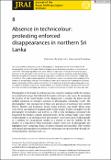Files in this item
Absence in technicolour : protesting enforced disappearances in northern Sri Lanka
Item metadata
| dc.contributor.author | Buthpitiya, Vindhya | |
| dc.date.accessioned | 2022-06-15T14:30:05Z | |
| dc.date.available | 2022-06-15T14:30:05Z | |
| dc.date.issued | 2022-06-15 | |
| dc.identifier | 278052905 | |
| dc.identifier | fcd7ee2b-497c-41db-88e0-4f99aeee8450 | |
| dc.identifier | 000789691100001 | |
| dc.identifier | 85130058921 | |
| dc.identifier.citation | Buthpitiya , V 2022 , ' Absence in technicolour : protesting enforced disappearances in northern Sri Lanka ' , Journal of the Royal Anthropological Institute , vol. 28 , no. S1 , pp. 118-134 . https://doi.org/10.1111/1467-9655.13758 | en |
| dc.identifier.issn | 1359-0987 | |
| dc.identifier.other | ORCID: /0000-0002-5374-0294/work/113061436 | |
| dc.identifier.uri | https://hdl.handle.net/10023/25539 | |
| dc.description | This research is a part of ‘Photodemos: Citizens of Photography – The Camera and the Political Imagination’ at UCL Anthropology. This project has received funding from the European Research Council (ERC) as part of the European Union’s Horizon 2020 research and innovation programme under grant agreement No 695283. | en |
| dc.description.abstract | This essay examines the political uses of photography in the protests of the Tamil families of the disappeared in northern Sri Lanka. Enforced disappearances have long featured as an instrument of state terror. Their lingering effects have been noted as a significant challenge to transitional justice processes in the aftermath of the island’s civil war. By examining how protesters make their political demands and grievances known through photography, I explore the tensions between visibility and surveillance. The competing photographies of the protests subvert conceptual understandings of the medium as an ideological tool, but also vex claims of its capacities for enabling emancipation. Against a backdrop of ethno-nationalist conflict, this mobilization of and through photography serves as a defiant articulation of post-war ‘irreconciliation’. It is further tethered to a global visual vernacular of civilian resistance challenging state atrocity, as well as irreconcilable assertions of nation and state. | |
| dc.format.extent | 17 | |
| dc.format.extent | 1018662 | |
| dc.language.iso | eng | |
| dc.relation.ispartof | Journal of the Royal Anthropological Institute | en |
| dc.subject | GN Anthropology | en |
| dc.subject | NDAS | en |
| dc.subject | SDG 16 - Peace, Justice and Strong Institutions | en |
| dc.subject | AC | en |
| dc.subject.lcc | GN | en |
| dc.title | Absence in technicolour : protesting enforced disappearances in northern Sri Lanka | en |
| dc.type | Journal article | en |
| dc.contributor.institution | University of St Andrews. Social Anthropology | en |
| dc.identifier.doi | 10.1111/1467-9655.13758 | |
| dc.description.status | Peer reviewed | en |
This item appears in the following Collection(s)
Items in the St Andrews Research Repository are protected by copyright, with all rights reserved, unless otherwise indicated.

